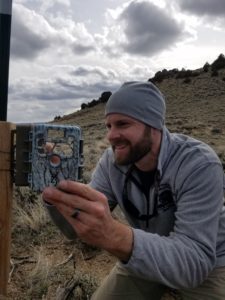Share this article
Q&A: Reconnecting wildlife managers and researchers
Wildlife managers and academic researchers are facing a growing disconnect that threatens to undermine their ultimate goals of conservation.
Jerod Merkle saw a disconnect between wildlife managers and academic researchers as far back as The Wildlife Society’s 23rd Annual Conference in Raleigh, N.C. when he and his colleagues put together a symposium on the growing divide between these two groups. The talks were well-attended by wildlife professionals from both sides of the divide, and a group decided to continue the conversation by writing a commentary paper.
The paper brought “specific researchers and managers together to really address the issues that were making it difficult to work together,” said TWS Canadian Section representative Evelyn Merrill, a biological sciences professor at the University of Alberta who spoke at the symposium and co-authored the paper recently published in the Journal of Wildlife Management.
“Interaction between wildlife managers and researchers will continue to evolve over time,” said co-author Kelly VanBeek, a wildlife biologist with the U.S. Fish and Wildlife Service. “Intentional, frequent and transparent interactions between managers and researchers help us move the needle on wildlife conservation. We often hear the phrase ‘breaking down silos’ in conservation today, with silos certainly being present across many organizations tasked with wildlife conservation. The JWM article is a firm reminder that wildlife science and management are most effective when endeavored upon together, when intentional communication moves us past our traditional management and research silos, and how TWS can help us bridge the gap.”
We caught up with TWS member Merkle, the Knobloch Professor of Migration Ecology and Conservation at the University of Wyoming and lead author on the commentary paper, “A collaborative approach to bridging the gap between wildlife managers and researchers,” to talk about why that gap exists and how it can be closed. Responses are edited for style and brevity.
Why is the gap between managers and researchers growing?
Our group identified three main reasons. First, researchers sometimes conduct applied research, but they don’t engage with managers from the onset. This can make managers’ decisions more difficult if the science doesn’t quite answer the right question or suggests actions that are socially infeasible.
Second, managers sometimes conduct their own research without collaborating with researchers. In this case, experimental design or statistical rigor could be lacking.
Third, researchers sometimes conduct awesome science, but they often don’t take that second step to turn it into an end product that a manager can use. Because researchers don’t have the extra time and are not rewarded for creating apps or decision tools for managers, it just doesn’t get done.

Jerod Merkle recently co-authored a commentary about bringing wildlife managers and researchers together. ©Bethann Garramon Merkle
All of these things can lead to managers and researchers not being on the same page, resulting in a breakdown in trust. That’s where the proverbial walls go up between researchers and managers.
What’s at stake if these relationships continue to drift apart?
You basically have less effective wildlife conservation. Without that backing of science and without managers and researchers working together, the influence of politics, economics and social factors might outweigh what we know from an ecology or biology standpoint.
Without the public seeing the connection between how research feeds into management and what we do on the ground, we’re going to have a tough time getting support for wildlife conservation and wildlife management. Less support might mean less funding for new research or on-the-ground conservation projects.
Additionally, if we don’t have science to back a given management action, it may face greater challenges in court. Without the research, actions can also get revoked for political reasons, or political forces can outweigh the biological in the decision.
Why is it important to foster collaboration between researchers and managers early in decisions or research?

Jerod Merkle checks a trail camera placed to record migrating deer, elk (Cervus canadensis), and pronghorn (Antilocapra americana) in Wyoming. ©Anna Ortega
When the manager and researcher work together from the onset — either in a research project or helping develop a management application or objective — you get mutual buy-in. When both parties agree on the research or decision, the effect can be stronger.
For managers it means getting research that actually helps them, since the research was developed with their input and is directly related to the management issue.
For the researcher, it means the research is going to be used for wildlife conservation. If they get that buy-in from the managers from the start, once it’s completed, managers are more likely to say “Ok, let’s implement what the research suggests. I understand the way it works, and I understand the uncertainty behind it.”
I don’t want to see a researcher going up to a manager after the fact and saying “Hey, check this out. Isn’t this great?” or a manager saying “Oh, we made this management decision, and we’ve gone down this rabbit hole. Researchers — what can you do to figure out why it is not working?” We need to get away from talking to each other so late in the game.
Can TWS play any part in closing this divide?
I think where all of the authors were in agreement was at the state level, where these discussions and disconnects can start to build bridges.
Discussions at the state level can be richer from a researcher/manager standpoint as it is clear how management and research can be implemented within a given wildlife herd or management unit. Whatever TWS can do to facilitate and ensure that both researchers and managers are going to the state meetings and interacting with each other is importan
Inviting managers to serve on graduate student committees, getting students involved agency newsletters or publications, or incentivizing internships where students work directly with managers can all help bridge the gap that disconnect. Anything that TWS can do to facilitate those interactions is going to be important.
Header Image:
Wildlifers work on a project involving common eiders (Somateria mollissima) in Alaska.
©Danielle Brigida/USFWS








